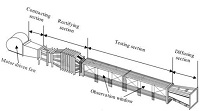On the Wind Reduction Effect of Windbreak Nets in Front of the Simple Greenhouse for Planting Fruits and Vegetables
Keywords:
windbreak net, porosity, tilt angle, wind tunnel testAbstract
The island of Taiwan experiences frequent strong winds coming with typhoons in the summer and with northeast monsoons in the winter. The strong winds are hazardous to the structure of a simple greenhouse that is widely used for vegetable and fruit plantation. The damage may reduce agricultural yields. Windbreak netting is a practical procedure for protecting a greenhouse from strong winds. The purpose of this study is to carry on the wind tunnel simulation test of windbreak nets in front of the simple greenhouse. Windbreak nets of densities 50%, 40%, 30% and 20% had a uniform dimension of 10 cm (per unit 1 h) in height and 29.2 cm in width. A windbreak net was tested at tilt angles of 0o, 5o, 10o and 15o. The wind tunnel simulation test is carried on at 10 m/s of reference wind velocity. The wind velocities at different horizontal distances and vertical distances front and behind the windbreak net are measured. The relative wind velocity is calculated. The wind reduction effect at different horizontal distances behind the windbreak net is analyzed and discussed. From the test results, it is known that when the tilt angle of windbreak net is 0o and the height of windbreak net is 1h, the corresponding wind reduction effect of windbreak nets with 20%, 30%, 40% and 50% porosity is 62%, 61%, 59% and 52% respectively at 2h horizontal distance. The corresponding wind reduction effect of windbreak nets with 20%, 30%, 40% and 50% porosity is 46%, 45%, 40% and 32% respectively at 10h horizontal distance. However, the increase of tilt angle of windbreak net does not have much influence on the wind reduction effect.
References
L. M. Huang, Y. Z. Jiang, and S. M. Kao, “Study on anti-wind strength for the material of windbreak net pillar,” Journal of Agriculture and Forestry, vol. 40, no. 2, pp. 11-28, June 1991.
Y. S. Tian, Z. H. Xiao, and J. Y. Zhang, “Application of windbreak net and accommodation at the adverse circumstance of strong wind,” Monthly Agricultural Magazine at Taichung Area, vol. 145, September 2011.
Q. Tang, Y. Sien, and B. H. Li, “Study on anti-wind distance for nylon windbreak net of sweetsop orchard at coastal region of Taitung,” Crop, Environment and Biological Information, vol. 5, pp. 40-51, 2008.
Y. Z. Jiang and L. M. Huang, “Study on the shelter effect for the erecting type of windbreak net,” Journal of Agriculture and Forestry, vol. 39, no. 1, pp. 15-56, May 1990.
Y. Z. Jiang and L. M. Huang, “Study on the optimal interval of windbreak net,” Journal of Agriculture and Forestry, vol. 39, no. 2, pp. 121-144, June 1990.
L. M. Huang, J. S. Li, M. W. Liu, and T. H. Cheng, “Study on wind tunnel test for the shelter effect of weaving type of windbreak net,” Journal of Agriculture and Forestry, vol. 61, no. 1, pp. 65-83, May 2012.
J. L. Santiago, F. Martín, A. Cuerva, N. Bezdenejnykh, and A. Sanz-Andrés, “Experimental and numerical study of wind flow behind windbreaks,” Atmospheric Environ. vol. 41, no. 30, pp. 6406-6420, September 2007.
W. M. Cornelis and D. Gabriels, “Optimal windbreak design for wind-erosion control,” Journal of Arid Environments, vol. 61, no. 2, pp. 315-332, April 2005.
Z. Dong, W. Y. Luo, G. Q. Qian, and H. T. Wang, “A wind tunnel simulation of the mean velocity fields behind upright porous fences,” Agricultural and Forest Meteorology, vol. 146, no. 1-2, pp. 82-93, September 2007.
J, P. Bitog, I. B. Lee, M. H. Shin, S. W. Hong, H. S. Hwang, I. H. Seo, J. I. Yoo, K. S. Kwon, Y. H. Kim, and J. W. Han, “Numerical simulation of an array of fences in Saemangeum reclaimed land,” Atmospheric Environment, vol. 43, no. 30, pp. 4612-4621, September 2009.
M. Du and T. Maki, “Effects of polyethylene windbreak net on drifting sand and microclimate,” J. Agric. Meteorol, vol. 52, no. 5, pp. 953-956, January 1997.
J. R. Brandle and H. D. Nickerson, “Windbreaks for snow management,” School of Natural Resources, Paper 125, January 1996.

Published
How to Cite
Issue
Section
License
Submission of a manuscript implies: that the work described has not been published before that it is not under consideration for publication elsewhere; that if and when the manuscript is accepted for publication. Authors can retain copyright of their article with no restrictions. Also, author can post the final, peer-reviewed manuscript version (postprint) to any repository or website.

Since Oct. 01, 2015, PETI will publish new articles with Creative Commons Attribution Non-Commercial License, under The Creative Commons Attribution Non-Commercial 4.0 International (CC BY-NC 4.0) License.
The Creative Commons Attribution Non-Commercial (CC-BY-NC) License permits use, distribution and reproduction in any medium, provided the original work is properly cited and is not used for commercial purposes



